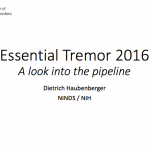Peter Muller, the founder of HopeNet was one of the first in the US to have Focused Ultrasound for his Essential Tremor. A study “Thalamic Tremor Following Focused Ultrasound Thalamotomy for the Treatment of Essential Tremor” has now been published exploring the results of the procedure on his tremor. You can find it here: Thalamic Tremor Following Focused Ultrasound Thalamotomy for the Treatment of Essential Tremor – Osterholt – – Movement Disorders Clinical Practice – Wiley Online Library
Movement Disorders
New therapy enters Phase II testing
Sage Therapeutics is about to begin Phase II testing of Sage-324 for Essential Tremor. There is a lot to learn about the way Sage is thinking about Neurological Disorders on their corporate website at:
- https://www.sagerx.com/programs-research/neurologic-disorders/
- https://www.sagerx.com/programs-research/pipeline/
- https://investor.sagerx.com/news-releases/news-release-details/sage-therapeutics-announces-clinical-updates-and-progress-across
ET, Balance, and Falls
Seven people with ET that I have known have died from falls. While the cause was not exclusively ET, it was a factor in all cases. Personally, my balance and gait have gotten worse. It is a combination of my ET’s progression and the consequence of the surgical treatment of my ET.
I was proud of myself because I had adjusted my balance to prevent falls. I was using my hands constantly while I walked or rose. I thought it was working, but it wasn’t. I had a very serious fall going up the stairs in which I seriously bruised my kidney. I was doing just about everything wrong!
Realizing that, I did something. First, I joined a water aerobics class. Many years ago, Jan Helper in the Columbia ET support group had told the group how well water aerobics had helped her. Finally, I started and immediately saw the advantage of doing it – the buoyancy.
Second, I started doing neurological physical therapy – with the emphasis on neurological. The practice I go to only handles people with neurological disorders. My young physical therapist fully understands movement disorders and their effects on the body. While she is nice, she is tough – constantly pushing. I had Marine Drill Instructors in the Navy; she is nicer but pushes just as hard as they did.
When I started, I walked like an Emperor penguin. I leaned forward – my shoulders were tense. My arms were out to the side, particularly my right one which was tense. I used my hands for everything. I took short steps. I needed to use my core to walk properly. I needed to relax, specifically my shoulders and arms. I had to quit using my hands and learn to rely on my legs.
It is not easy to learn how to walk again. It takes a lot of repetition and strengthening of the legs. Of real importance is to relax, relax, relax.
When my therapist learned I did the water aerobics from 9-10am twice a week, she scheduled me from 11:30-1pm on the same days. It takes me the intervening time to change and drive. An important part of the therapy is that I must be tired. At the end, particularly on Thursday, I am!
It is a long-lasting effort. I must remain committed and persistent.
As I have said repeatedly, everyone’s ET is unique. This may or may not be right for you. However, alternative treatments for ET do work!
— Peter Muller
What does it mean to have a disorder like ET?
 What does it “mean” to have a disorder like ET? It’s not a disease. As you and I know it’s probably more like an umbrella term covering a family of different problems all united by one primary symptom – tremor. How do we gain more knowledge about ET and our own conditions? Having a visible tremor is a “sign” to others that there is something wrong with our brains. What this means to others has a direct bearing on what it means to us. And it’s not easy to communicate what it’s like to have ET to others, including health professionals. So how do we know what is important to communicate?
What does it “mean” to have a disorder like ET? It’s not a disease. As you and I know it’s probably more like an umbrella term covering a family of different problems all united by one primary symptom – tremor. How do we gain more knowledge about ET and our own conditions? Having a visible tremor is a “sign” to others that there is something wrong with our brains. What this means to others has a direct bearing on what it means to us. And it’s not easy to communicate what it’s like to have ET to others, including health professionals. So how do we know what is important to communicate?
New research comes out, and it’s hard not to personalize it and assume that whatever it says applies to me or to be upset that it clearly doesn’t apply to me! There are many studies of people with ET that show an inflated rate of this or that among people with ET. As an epidemiologist, let me tell you the main problem I have with some of these studies: many of these studies don’t bother to provide or consider the base rate—this is the rate of a particular disorder in the general population, and it helps one understand whether a finding means anything in particular.
Let’s take depression for instance. A study tells you that X% of those with ET also have depression. Gosh, you might say, this may mean my ET makes it more likely that I’ll be depressed. (Well if you kept missing your mouth when you tried to eat peas or apply lipstick, you might also have some general distress towards your functioning – but hey, that’s distress, not depression, which is a clinical diagnosis with many symptoms over at least a two-week time span). What the researchers often don’t tell you is whether this rate is more or less than in the population at large. In fact, depression is a prevalent problem in the general population! Here’s where I have to get a little specific. Again, depression requires a group of symptoms that occurred for at least a two-week period. So if we are asking people about the last two weeks, all we can find is if they are currently in a two-week period of depression. If they started coming out of it a week ago, we won’t accurately measure the fact that in the last 30 days they have been depressed. If we measure the last 30 days only, we won’t know if they had a depressive episode last month that may have resolved enough – not completely, but enough – for them not to reach diagnostic criteria. Finally, if we measure lifetime, we might find out if they have EVER had depression. This ever category is always the biggest. It counts the prevalence of past-30-day (commonly called current) depression and it counts any lifetime episode. Measured this way, one in five people in the U.S. has ever been depressed. So if a study measures the association of depression, lifetime, with ANYTHING, it is very likely to be positive, to look elevated, if you don’t account for the base rate of the disorder in the population. I’m only using depression as an example. The bottom line is that we have to remember when we read the literature that just because someone finds that something is associated with ET doesn’t necessarily mean much. It doesn’t mean with our type of ET we are at higher risk for another disorder or disease.
So what do we need to be communicating to health professionals and, in turn, to researchers? What don’t they know that prevents them from being able to help us with? What about that my hand tremor is only a small part of what my ET is and how it affects me. Lately when I’m laying down to sleep, my neck and head tremor bother me and keep me from falling asleep. I try to get in a position that will lessen it, but I find it difficult to do. I’m still taking less propranolol than I could; maybe it would go away if I took more, or really cut out caffeine from my diet. I also realize that for years I’ve been clenching my jaws to cut down on jaw tremor. Not good for the enamel on my teeth or for my joint! Here’s another weird one – maybe you can relate, maybe not. When someone picks a table that will cause people to sit really close together, or in theaters or other places where the chairs are really small, and some of the people just have to spread their legs and take up lots of space, I’ll be really uncomfortable. Why? Because I’ll be almost forced to activate my muscles to hold my legs closely together, and that will lead to tremor, and then I’ll be really uncomfortable; and honestly it’s hard for me to even communicate what I’m talking about to people who don’t have a tremor. Actually I think the list of what I don’t share about my ET is huge. I didn’t realize it until I started writing this! And that’s just about different tremors, probably not the most important thing about ET to me.
That is the feeling I get when I forget to take my medicine. I feel off balance, like something inside knows something isn’t quite right. And I don’t really see that reflected in the literature. What is in the literature may not at all reflect my ET. It might not reflect yours. That puts an additional burden on each of us to communicate how ET affects us for our own sake, and to build the knowledge base about how ET affects people. I’m hoping we’ll make progress in understanding and treating what we now call ET. It’s going to take new research – but it’s also going to take persons with ET speaking up about what matters most.
——-
Dr. Catherine Striley is a professor of epidemiology at the University of Florida, Gainesville and has had ET since her early childhood. She therefore has the condition while being a member of the medical community.
Your Donations Sought to Support Essential Tremor Projects
 For the past two years. HopeNET has not actively solicited donations. We have been able to do so because we are an all volunteer non-profit.
For the past two years. HopeNET has not actively solicited donations. We have been able to do so because we are an all volunteer non-profit.
However circumstances have changed due primarily to two projects:
* A formal study of Essential Tremor and balance and gait. There has been very little research on this issue even though it is a critical issue facing many who have ET. The study is tentatively scheduled to begin this fall. It will be conducted by Janice Sallitt, PT, DPT, NCS. She specializes in Orthopedic & Neuro PT. The study will center on HopeNET’s Columbia, Maryland ET support group.
* In an attempt to increase awareness of Essential Tremor, Mary Cae Asay is going to produce a play about Katherine Hepburn. Because of Mary Cae’s ET, she can make her voice sound identical to Hepburn’s.
More details will follow. These are very exciting times for HopeNET. Please continue to follow our Facebook and Blog as HopeNET continues to take active steps aimed at improving the lives of those with Essential Tremor.
Your donation will be greatly appreciated.
Peter
On Being a School Teacher with Tremor
 “Mrs. Slaughter, why does your head shake?” You have to just love the power of observation that children have, especially middle schoolers. With this seven word question my journey with essential tremor became a topic that I really wanted to just keep private. This was 12 plus years ago. The first neurologist I went to actually knew something about ET. Reassured by the doctor that it wasn’t Parkinson’s disease and with my Primidone prescription in hand my journey began. With that blunt question from a student I knew I could no longer keep my “problem” a secret. So this was the beginning of the wonderful first days of school explaining in each class why they would see my head shake. Not something I wanted to deal with but again children are very curious and won’t stop the questions unless they get a satisfactory answer. So for the next few years medication controlled the tremors to some degree but they were always present and needed at times to be explained, even to the parents. Parents quite understandably want the best for their child but in many ways, deep down; I felt this was an invasion of my personal life but what can you do when it is so visible. A couple of years ago when the Primidone no longer was helping and the stress level from teaching was causing the tremors to magnify, I retired. I now have a new neurologist, a more accurate diagnosis of dystonia, no longer take Primidone and am seeking a different method to control the tremors. I would love to end this with I was cured but if you have ET you know that is not the end of this story. So I will continue to become better educated about this inconvenience and laugh at myself sometimes so I can remind myself that I am strong enough to keep doing all the things I want to do for as long as I can.
“Mrs. Slaughter, why does your head shake?” You have to just love the power of observation that children have, especially middle schoolers. With this seven word question my journey with essential tremor became a topic that I really wanted to just keep private. This was 12 plus years ago. The first neurologist I went to actually knew something about ET. Reassured by the doctor that it wasn’t Parkinson’s disease and with my Primidone prescription in hand my journey began. With that blunt question from a student I knew I could no longer keep my “problem” a secret. So this was the beginning of the wonderful first days of school explaining in each class why they would see my head shake. Not something I wanted to deal with but again children are very curious and won’t stop the questions unless they get a satisfactory answer. So for the next few years medication controlled the tremors to some degree but they were always present and needed at times to be explained, even to the parents. Parents quite understandably want the best for their child but in many ways, deep down; I felt this was an invasion of my personal life but what can you do when it is so visible. A couple of years ago when the Primidone no longer was helping and the stress level from teaching was causing the tremors to magnify, I retired. I now have a new neurologist, a more accurate diagnosis of dystonia, no longer take Primidone and am seeking a different method to control the tremors. I would love to end this with I was cured but if you have ET you know that is not the end of this story. So I will continue to become better educated about this inconvenience and laugh at myself sometimes so I can remind myself that I am strong enough to keep doing all the things I want to do for as long as I can.
— Mary Jane Slaughter
Tai Chi for Essential Tremor Class Started
Dr. Sean Vasaitis is a professor at the University of Maryland Eastern Shore. He is a young man who has had Essential Tremor since he was a child. He found that Tai Chi was an effective treatment for his ET. He consequently undertook an extensive program to learn Tai Chi. This involved a number of trips including this past winter to Northwest China to learn from the real experts of Tai Chi.
He is conducting a formal study of Tai Chi as a treatment of ET. He is using HopeNET’s Silver Spring ET support group as a test group. Yesterday, April 28, was the first class. It was conducted at Leisure World Maryland. Renee, a faithful member of the group, sent me this message below.
If you are interested in participating, please let me know.
— Peter
Dr. Dietrich Haubenberger of NINDS/NIH Gives Presentation On ET Outlook
 When we founded HopeNET 5 years ago, we felt that the thing that the ET community needed most at that time was HOPE – hence the name. In the meantime, we have strived hard to bring some hope to all with ET. Accordingly, HopeNET played a key role in having the ET conference at NIH in May 2015. Since that conference, there has been a big increase on the part of industry in developing new treatments for ET. Dr. Dietrich Haubenberger of NIH is probably in the best position to know what is going on with ET. He came to the Falls Church, Virginia ET support group on October 14th and made the attached presentation, Essential Tremor 2016: A look into the pipeline. There has never been a better time than right now for hope – for all of us in the ET community.
When we founded HopeNET 5 years ago, we felt that the thing that the ET community needed most at that time was HOPE – hence the name. In the meantime, we have strived hard to bring some hope to all with ET. Accordingly, HopeNET played a key role in having the ET conference at NIH in May 2015. Since that conference, there has been a big increase on the part of industry in developing new treatments for ET. Dr. Dietrich Haubenberger of NIH is probably in the best position to know what is going on with ET. He came to the Falls Church, Virginia ET support group on October 14th and made the attached presentation, Essential Tremor 2016: A look into the pipeline. There has never been a better time than right now for hope – for all of us in the ET community.
— Peter
Dr. Dietrich Haubenberger of NINDS/NIH Gives Presentation On ET Outlook
 When we founded HopeNET 5 years ago, we felt that the thing that the ET community needed most at that time was HOPE – hence the name. In the meantime, we have strived hard to bring some hope to all with ET. Accordingly, HopeNET played a key role in having the ET conference at NIH in May 2015. Since that conference, there has been a big increase on the part of industry in developing new treatments for ET. Dr. Dietrich Haubenberger of NIH is probably in the best position to know what is going on with ET. He came to the Falls Church, Virginia ET support group on October 14th and made the attached presentation, Essential Tremor 2016: A look into the pipeline. There has never been a better time than right now for hope – for all of us in the ET community.
When we founded HopeNET 5 years ago, we felt that the thing that the ET community needed most at that time was HOPE – hence the name. In the meantime, we have strived hard to bring some hope to all with ET. Accordingly, HopeNET played a key role in having the ET conference at NIH in May 2015. Since that conference, there has been a big increase on the part of industry in developing new treatments for ET. Dr. Dietrich Haubenberger of NIH is probably in the best position to know what is going on with ET. He came to the Falls Church, Virginia ET support group on October 14th and made the attached presentation, Essential Tremor 2016: A look into the pipeline. There has never been a better time than right now for hope – for all of us in the ET community.
— Peter
Essential Knowledge Gaps in the field of Essential Tremor Conference
The conference entitled Essential Knowledge Gaps in the field of Essential Tremor was held on May 11-12, 2015. It was broken into 5 sessions – (1) Phenomenology & Phenotypes, (2) What can we learn from available therapies & what do we need to implement clinical trials and advance clinical research in ET, (3) Physiology of Essential Tremor, (4) Pathology, and (5) Genetics.
For each of the above discussion points, an expert in the respective field made a presentation regarding the topic. The discussion was then open to all of the participants. This was followed by a summary of what had been discussed. As one who has Essential Tremor and is not a doctor, I was impressed by how it was conducted and the points that were made.
I am optimistic. There are big challenges ahead – not the least is – we need a better understanding of what Essential Tremor is. The various working groups will now take their respective summaries and put together a more specific plan for moving forward.
NINDS did a good job with the conference. I am confident that they will continue to play a constructive role in ensuring that follow up occurs.
Peter
